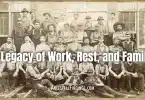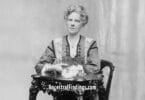In the world of colonial American women, the stories are usually quite similar. They are born to a family of humble background, raised to be a good Christian wife, married a cousin or close neighbor, had a house full of children, and either died in childbirth or lived to a wizened old age, surrounded by her devoted progeny. With the monotony of day-to-day life in the colonial period for the vast majority of people of the time, there was not much room for adventure. Yet, some women did manage to find it, either on purpose or by accident. Margaret Otis, also known as Christine Baker, is one of these women, with a story as remarkable as it is unlikely and definitely book-worthy. This is what you need to know about this colonial woman who came from an average background, but who had a life that was anything but ordinary.
Born on March 15, 1689, Margaret Otis was the daughter of a blacksmith from Dover, New Hampshire named Richard Otis, and his third wife, Grizel Warren. Both of Margaret’s parents were the children of emigrants from England to the colonies. Richard’s first wife, Rose Stoughton, was even part of the British aristocracy, whose father had sent her to the colonies to get her away from the dangers of the English Civil War. Richard Otis and his family were among the first people of English descent to move to the newly established town of Dover, New Hampshire.
Richard had children with each of his wives, including two with his third wife, Grizel—daughters Hannah and Margaret. They were born at a time when the relations between the settlers of Dover and the Native Americans who lived there were tenuous, ranging from friendly to decidedly not, and often the relations were individual to each family in the town.
At the time Margaret was born, there had been peace of fifty years between the citizens of Dover and the local native Penacook tribe. A newly appointed leader in a town named Richard Waldron put an end to that long-established peace by betraying a group of Natives from another tribe to the English in Massachusetts, who wanted them executed for their part in a local massacre. The Penacook was enraged at the betrayal of their brethren tribe and vowed revenge on Waldron. This also meant revenge on the citizens of Dover. Margaret was only an infant at this time.
While no harm came to any of the Penacook during this incident, they felt betrayed nonetheless. The Penacook came up with a plan for revenge that involved most of the town of Dover, with just a few notable exceptions of families that had especially excellent relations with them. On June 27, 1689, when Christine was just three months old, the Penacook engaged in a raid on Dover.
This raid was aided by some Penacook women who showed up at local garrison (fortified) houses to ask for shelter for the night—a common occurrence. When the members of the households had gone to bed, the Penacook women unlocked the garrison gates that surrounded the houses and let them inside. Entire families were massacred. Those that weren’t killed were rounded up and taken to Canada to be sold to the French. Margaret’s family was among those affected. Her father was killed, as was her older sister, the two-year-old Hannah, whose head was dashed against the hearthstones because the Penacook thought it would be inconvenient to drag a toddler through the wilderness. Many of her uncles and cousins were also killed, and aunts and other cousins were taken to Canada. She and her mother Grizel were among those taken to Canada. The Penacook felt that Margaret, though she was a baby, would be easier to manage on the wilderness trail because Grizel could carry her.
While one of the two groups of captives from Dover were ransomed and returned home, the group with Grizel and Margaret were not. Once they reached Canada, Grizel was purchased by a French settler by the name of Lagarenne. Margaret was a packaged part of the purchase of Grizel. Yet, Lagarenne did not keep Grizel as a slave, as some of the other French did with captives from the English colonies. Instead, he freed and married her. There was a condition to this freedom and the protection marriage offered a woman and her infant child of this time—they had to convert from their strict Puritan Protestant religion to Catholicism, as this was still the official religion of France and its colonies. Grizel converted, though it must have been offputting for her. She had to think of the safety of herself and her child, though.
As part of the conversion, both Grizel and Margaret were baptized into the Catholic church and given new, more Catholic names. Grizel was re-christened Marie Magdaleine, and Margaret was re-christened as Christine. She used the name Christine for the rest of her life.
As a small child, Christine was sent to a convent school, where she was educated among sequestered nuns. There, she received an exceptional education, one that was far superior to the ones most girls in colonial New England were afforded. Yet, along with this amazing education came pressure from the nuns to join them and take up the veil. Christine did not want to do this, as she did not feel called to it. She wanted a husband and children, which would not be allowed to her if she became a nun.
With the evidently headstrong Christine steadfastly refusing to become a nun, her mother and step-father arranged a marriage for her once she was of age for it to be considered. Catholic girls in Canada married at much younger average ages than New England Puritan girls. While no one could force her to become a nun, they could force her to get married, and to whoever her guardians approved. This was done. Christine was married to Louis LeBeau on June 14, 1707. She was eighteen years old at the time.
Christine and Louis had three children together, a son and two daughters. Only the daughters lived past childhood. At some point during the seven years, Christine was married to Louis, she met a young captive from New England, a handsome man named Thomas Baker. Thomas was a captain in the militia in Massachusetts. While captive in Canada, Thomas tried to escape and was caught and ordered to be shot. Christine’s husband Louis paid to have Thomas ransomed and set free.
Thomas made an impression on Christine, and after her husband ransomed him and he was allowed to return to New England, they remembered and thought of each other. Not long after Thomas left Canada, Christine’s husband Louis died in 1713. This left her as a twenty-five-year-old widow with two young children. The next year, in 1714, Thomas Baker came back to Montreal, where Christine lived. This time, it was voluntary, as he was part of a contingent of Puritan troops sent to ransom back some captives from the colonies who were there. Thomas and Christine met each other again sometime during Thomas’s second trip to Montreal.
In fact, Thomas tried to include Christine among the list of those colonial captives who were to be ransomed to freedom. Even though Christine had been raised in Montreal and did not remember the colonies at all, she wanted to go there with him. It was clear they were in love.
The French authorities in Montreal refused to allow Christine to go at first but later relented after some conditions were met. The conditions the French authorities imposed were harsh and were intended to make her choose to stay. Christine was not to be allowed to take any personal belongings with her, only the clothes on her back could go. Also, most importantly, she could not bring her two daughters with her if she chose to leave.
As a surprise to everyone, Christine agreed to these conditions and made plans to leave for the colonies with Thomas. Her mother Grizel, accustomed to French life at this point, tried to talk her out of it, famously telling Christine that she knew nothing of the hardships of life women faced in New England, where they had to make their own bread and butter by hand, rather than buying it at a store as they did in Montreal. Christine had training on how to make these things. As any young woman in love might do, she said she was going with Thomas anyway.
Still, she did not just hike up her skirts and leave without trying to get around those harsh conditions imposed on her release. She and Thomas tried to smuggle her household goods, along with her two daughters, out of Montreal on a boat. Parish priests discovered them and took everything on the boat except Christine and Thomas, including Christine’s daughters. Christine was not deterred and left with Thomas once more, this time truly only bringing the clothes she was wearing and whatever she could carry in her hands, which was all the conditions of her release permitted her.
Christine arrived in New England in September of 1714, twenty-six years after she was taken from it as an infant. She and Thomas Baker married each other in January of the following year. Together, they lived in Brookfield, Massachusetts, until 1734. After that, they moved to the town of Christine’s birth, Dover, New Hampshire—which was also the scene of her initial capture by the Penacook Natives.
Once in Dover, Christine was re-baptized (the third baptism in her life) into the Puritan church, and her original name of Margaret was restored to her, though she continued to go by Christine. Christine engaged in ongoing negotiations with the French authorities in Montreal to secure the return of her two daughters. In their turn, the French were concerned that Christine’s re-baptism into the Protestant church meant she was falling into heresy, and they took an unusual interest in getting her to come back to Montreal and to the Catholic church.
Christine’s old parish priest from Montreal sent her letters for years, trying to get her to come back to Montreal and the Catholic church. As the priest made theological arguments for why she should do this, Christine showed the letters to her Puritan minister, who gave her theological arguments of his own for her staying that she wrote into her own letters back to the priest.
In 1718, Christine made a return trip to Montreal, not to be reconciled to the Catholic church, but to get her daughters. The parish priests in Montreal had most of the political power there, and not only refused to let the girls go, but they also refused to even let Christine see them. The girls died a few years later, four years apart from each other, at ages ten and sixteen, respectively. Mother and daughters never met in person again after Christine left Montreal.
In 1727, a year after the last of Christine’s two daughters died, and the same year her son Otis Baker was born to her and Thomas, her old parish priest wrote her one more letter with reasons why she should come back to the Catholic church in Canada. Christine asked the governor of Massachusetts to reply for her this time, and the parish priest did not write to her again after that.
Because Christine’s story of infant abduction was well-known, she was treated like a celebrity when she returned to New England. She and Thomas were granted free land in Deerfield, Massachusetts, and they built a house on it after marrying. When they later sold it and moved to Dover, the people of her first hometown welcomed their local heroine’s homecoming by granting her five hundred acres of prime land there. Christine easily sold this land for a high value, and she and Thomas used the money to build a house in Dover. Thomas was mostly an invalid at this point, from injuries sustained in his military career. Christine turned part of their house into a profitable tavern, which she operated on her own. She was an astute businesswoman.
Christine’s tavern had a wholesome reputation, unlike most businesses of that kind. Because the Puritan authorities even approved of it, which was almost unheard of for a New England tavern, most New Englanders made a special point to visit it when they were in Dover.
Thomas Baker died in 1753, and Christine lived on for almost another two decades, she died on February 23, 1773, just before the American Revolution, but close enough to it she would have heard talk of the cause of liberty. She and Thomas were buried together in the same plot in Dover. Their love story, and Christine’s personal story, still captivates the people of Dover, New Hampshire, three centuries later.






